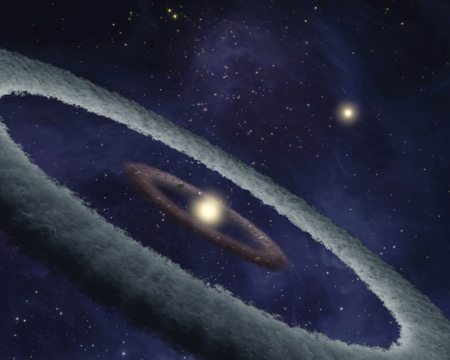Some interesting news from Spitzer Space Telescope: astronomers have spotted a disk of material orbiting one of the two stars in the binary system star HD 113766, located a little over 400 light years from Earth. The disk of material is loaded with rocky material, and is at the right distance from the star to be in the “Goldilocks zone”, where temperatures are right for a habitable planet.
 |
| Artist’s impression of the system HD 113766 |
While this is an interesting news story, it has the potential to get away from us (I expect to see “Earth-like planet forming nearby!” headlines any second now). Update: I called it.
First, let me be clear: no planet has been seen! The conditions are correct to form one, though. The disk has enough material to form a planet the size of Mars or so; small, but maybe not too small. The system is about 10 million years old, which is favorable as well: a planet forming at that distance from the star won’t have too much hydrogen and helium associated with it, since the star would have blown those lighter elements away by now.
However, I’m not sure such a small body would retain much of that atmosphere anyway; the cores of Jupiter and Saturn are much larger than Mars. When they formed, the planets’ cores were probably bigger than Mars, which is why they had enough gravity to hold onto their dense atmospheres made up of the lighter elements.
Also, given the size of the belt itself, I wonder if that material will be able to to form a planet at all. Mars formed in our solar system, of course, but our planetary disk was much larger than this one. I am not an expert here (anyone here know more about this? Comment!) but it seems likely to me that a disk that thin may not be able to coalesce into a planet; it may stay as an asteroid belt. You need a certain density of material for it to form planets easily, and this disk may not get above that limit. Again, I’m not sure; the paper is not online yet (not even at astro-ph!).
Orbiting much farther out is another belt made of lighter compounds like water ice, which is also interesting. It doesn’t have nearly as much material in it, but could still coalesce into millions of comet-like bodies, equivalent to our own Kuiper Belt out past Pluto. Perhaps gravitational disturbances from the second star in the binary will cause those comets to scream down on the new planet (assuming a planet can form), loading it with water… which is very cool indeed. When we get the technology to start really seeing planets, to resolve their surfaces, I wonder… how many will be smaller planets covered in water? Tiny Mars-like water worlds, circling distant Suns; is that what we’ll find?
Every time we dig a little deeper, probing newly-forming systems, we get surprises. Planets forming farther out than we expect, supermassive planets ten times the bulk of Jupiter orbiting a scant few million kilometers off their parent stars, whipping around them in just days, a tail of boiled off atmosphere streaming behind them…
The Universe is a weird place, and we’re only just starting to figure that out. The surprises are the best part!